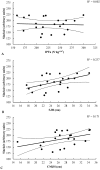Identifying a Test to Monitor Weightlifting Performance in Competitive Male and Female Weightlifters
- PMID: 29910350
- PMCID: PMC6026842
- DOI: 10.3390/sports6020046
Identifying a Test to Monitor Weightlifting Performance in Competitive Male and Female Weightlifters
Abstract
Monitoring tests are commonly used to assess weightlifter’s preparedness for competition. Although various monitoring tests have been used, it is not clear which test is the strongest indicator of weightlifting performance. Therefore, the purpose of this study was to (1) determine the relationships between vertical jump, isometric mid-thigh pull (IMTP) and weightlifting performance; and (2) compare vertical jumps to IMTP as monitoring tests of weightlifting performance in a large cohort of male and female weightlifters.
Methods: Fifty-two competitive weightlifters (31 males, 21 females) participated in squat and countermovement jump testing (SJ, CMJ), and IMTP testing performed on force plates. All laboratory testing data was correlated to a recent competition where the athletes had attempted to peak.
Results: Squat jump height (SJH) was the strongest correlate for men and women with the Sinclair Total (r = 0.686, p ≤ 0.01; r = 0.487, p ≤ 0.05, respectively) compared to countermovement jump height (r = 0.642, p ≤ 0.01; r = 0.413, p = 0.063), IMTP peak force allometrically scaled to body mass (r = 0.542, p ≤ 0.01; r = −0.044, p = 0.851) and rate of force development at 200 ms (r = 0.066, p = 0.723; r = 0.086, p = 0.711), respectively. Further, SJH was a stronger correlate of relative weightlifting performance compared to IMTP peak force in females (p = 0.042), but not male weightlifters (p = 0.191).
Conclusions: Although CMJ and IMTP are still considered strong indicators of weightlifting performance, SJH appears to be the most indicative measure of weightlifting performance across a wide-range of performance levels. Thus, SJH can be used as a reliable measure to monitor weightlifting performance in male and female weightlifters.
Keywords: Sinclair; clean and jerk; countermovement jump; isometric mid-thigh pull; jump height; peak force; rate of force development; snatch; squat jump; weightlifters.
Conflict of interest statement
The authors declare no conflict of interest.
Figures


References
-
- Stone M.H., Kenton B. Exercise and Sport Science. Lippincott Williams & Wilkins; Philadelphia, PA, USA: 2000. Kirksey Physiology of Weight Lifting; pp. 941–954.
-
- Di Naso J.J., Pritschet B.L., Emmett J.D., Owen J.D., Willardson J.M., Beck T.W., DeFreitas J.M., Fontana F.E. Comparing thigh muscle cross-sectional area and squat strength among national class Olympic weightlifters, power lifters, and bodybuilders. Int. J. Sports Med. 2012;13:48–57.
-
- Harbili S. Relationship between lower extremity isokinetic strength and anaerobic power in weightlifters, basketball and soccer players. Isokinet. Exerc. Sci. 2015;23:93–100. doi: 10.3233/IES-150569. - DOI
-
- Mcbride J.M., Triplett-Mcbride T., Davie A., Newton R.U. A Comparison of Strength and Power Characteristics between Power Lifters, Olympic Lifters, and Sprinters. J. Strength Cond. Res. 1999;13:58–66.
LinkOut - more resources
Full Text Sources
Other Literature Sources

